History of LSU Tigers football
The LSU Tigers football team represents Louisiana State University in the sport of American football. The university has fielded a team every year since it began play in 1893, except in 1918 due to World War I. It has competed in the Southeastern Conference (SEC) since 1933, and in the conference's Western division since 1992. Previously, LSU was a member of the Southern Intercollegiate Athletic Association (SIAA) from 1896 to 1921 and the Southern Conference (SoCon) from 1922 to 1932. There have been 32 head coaches for the team, starting with Charles E. Coates in 1893. Since 2016, the head coach of the Tigers is Ed Orgeron. LSU has played 1,221 games in its 123 seasons of play, and has compiled an all-time record of 772 wins, 405 losses, and 47 ties as of the end of the 2016 season.
1800s (1893–1899)
Charles Coates

Dr. Charles E. Coates, a chemistry professor at the university known for his work on sugar, and former football player at Johns Hopkins, assembled a group of students to create the school's first team. Coates' plan for a football team dated back to autumn of the previous year, when he assembled a team and held one or two scrimmages before shelving the idea for the following autumn.
The team wore makeshift uniforms with purple and gold ribbons for its first game, a 34–0 loss to Tulane and the only game played by LSU that year. The game was played in front of a crowd of 1,500 at Crescent City Base Ball Park in New Orleans.[1] The game sparked a rivalry between the schools that lasted well into the 20th century. Future Louisiana governor Ruffin G. Pleasant was the quarterback and captain of the LSU team.
According to legend, purple and gold were chosen because they were Mardi Gras colors, and the green was sold out.[n 1] The game was the only one Coates ever coached, and the only football game Pleasant played in. Pleasant was later inducted into the LSU Athletic Hall of Fame.[2]
Al Simmons
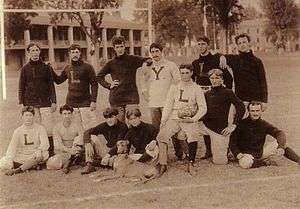
LSU achieved its first victory by beating Natchez Athletic Club 26–0 in 1894. Samuel Marmaduke Dinwidie Clark has the honor of scoring the very first touchdown in LSU history. The first football game played on the LSU campus was at State Field on December 3, 1894, a loss against Mississippi. LSU's only touchdown in that game was scored by the head coach, Albert Simmons.[3] This was the first year of play for William S. Slaughter who lettered as an end for 5 years (1894, 1895, 1896, 1897, 1898). Slaughter was LSU's first five time football letterman. By 1895, LSU had its first win in Baton Rouge.
Allen Jeardeau
In 1896 LSU hired Allen Jeardeau of Platteville, Wisconsin. LSU went undefeated, winning the school's first conference championship in the school's first year as a member of the Southern Intercollegiate Athletic Association (SIAA), the first southern athletics. conference.[4] Tulane was forced to forfeit for its attempt to play Hall of Fame Penn back George H. Brooke.[5] This was the first team to be called the "Tigers." The mascot was reputed to be named after the “Fighting Tigers,” the name of the 9th Louisiana Infantry in the Civil War.[6] Coach Jeardeau returned for his second but final year at LSU in 1897 for two games in Baton Rouge. A yellow fever outbreak throughout the South caused the postponement of LSU's classes starting, and the football season being cut back to only two games.

Edmond Chavanne
Another outbreak of yellow fever similar to the one in 1897 caused LSU to play only one game in 1898. By the time LSU was able to play its only game of the season, Allen Jeardeau had departed from the school as head football coach, and no provision had been made to replace him. The job of coach then fell to the team's captain, Edmond Chavanne, thus the first LSU alumnus to coach the team.
John P. Gregg
New coach John P. Gregg led the Tigers to a 1–4 season in 1899, including a loss to the "iron men" of Sewanee. The only wins were in an exhibition game against a high school team (which LSU does not officially record as a win) and against rival, Tulane. It was the first year of play for LSU's second five-year letterman, John J. Coleman (1899, 1900, 1901, 1902, 1903).
Building the program (1900–1931)
Chavanne, Borland, and Killian

Chavanne was rehired in 1900, posting a 2–2 record. Chavanne was replaced by W. S. Borland as head coach in 1901, leading the team to a successful 5–1 season. After the Tulane game, a 22–0 loss, LSU protested to the SIAA, and alleged that Tulane had used a professional player during the game. Several months later, the SIAA ruled the game an 11–0 forfeit in favor of LSU.[7] The seven-game 1902 season was the longest yet for the Tigers and also featured the most games on the road. LSU upset Texas, avenged last season's loss to Auburn, and lost only to Vanderbilt, which claimed an SIAA title after the win. The 1903 season broke the previous season's record for most games played (seven) with nine games.
Dan A. Killian coached the Tigers from 1904 to 1906. Back René A. Messa made some All-Southern teams in 1904. The 1905 team went 3–0.
Edgar Wingard
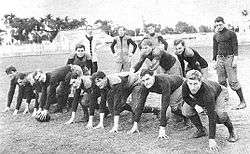
In 1907, LSU became the first American college football team to play on foreign soil in the Bacardi Bowl against the University of Havana on Christmas Day in Havana, Cuba. LSU won 56–0. John Seip ran back a 67-yard punt return.
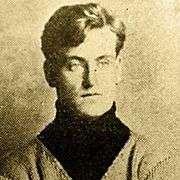
The 1908 team posted an undefeated 10–0 record. Quarterback Doc Fenton led the nation in scoring with 132 points, posting then school records of 36 extra points and 6 field goals. Mike Lally was his running mate in the backfield. LSU beat Auburn 10–2, Seip going over for the first touchdown. Auburn's 2 was had by a safety, after T. C. Locke blocked Fenton's punt. Fenton could not recover the fumble because he was knocked unconscious by a spectator's cane.[8]
The National Championship Foundation retroactively awarded 1908 LSU the national championship though it is not claimed by LSU. This season also led to an SIAA championship; but was clouded by accusations of professionalism from Grantland Rice and rival school Tulane.[9] Auburn and Vanderbilt were among those listed as alternative conference champions. Both Fenton and Seip were inaugural inductees into the LSU Athletic Hall of Fame.
Pritchard and Mayhew
1910 was a disastrous year for the Tigers. After a strong 1909 campaign under coaches Joe Pritchard and John W. Mayhew, which saw their only conference loss come to SIAA champion Sewanee, the team lost some star power; Stovall, Lally, and Seip had all graduated.[10]
Pat Dwyer
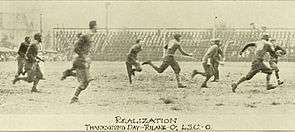
Pat Dwyer, an assistant at Auburn in 1908, was hired in 1911. He once used guard Tom Dutton for a "kangaroo play" in which back Lawrence Dupont would crawl between Dutton's legs; supposedly very effective in short yardage situations.[11] The 1913 team lost only to SIAA champion Auburn by a touchdown. Fullback Alf Reid made All-Southern.[12]
McDonald, Sutton, Pray, and Bocock
LSU's largest loss margin came on October 31, 1914 in a game against Texas A&M in Dallas, Texas. The final score was Texas A&M 63, LSU 9. In 1916, Walter Camp gave Phillip Cooper honorable mention on his All-America team. Irving Pray and Dana X. Bible also served as the Tigers coach in 1916.
Washington's Wayne Sutton coached the 1917 team to a 3–5 record.
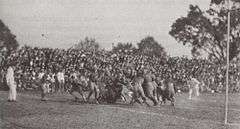
Irving Pray coached full seasons in 1919 and 1922, the inaugural season of the Southern Conference (SoCon).
Branch Bocock led the Tigers for the 1921 season, in which they were beaten only by Tulane.[13]
Mike Donahue
Mike Donahue came from Auburn to be the seventeenth head football coach at LSU in 1923. The biggest win in Donahue's tenure was probably the 20–14 victory over Indiana in 1924.[14] The final game of the 1924 season saw the first game played at Tiger Stadium, with an original seating capacity of 12,000, on Thanksgiving Day against Tulane. 18,000 fans managed to fit into the stadium to watch the Green Wave defeat the Tigers 13–0.[15] In 1925, the team's first full season in Tiger Stadium began with shutout wins over Louisiana Normal and Southwestern Louisiana. The following week coach Wallace Wade's national champion Alabama blew-out LSU in Tiger Stadium, 42–0, which was at the time the worst home loss in school history.[15] The 1925 team also beat John Heisman's Rice team, but ended the season with a second straight shutout loss to Tulane.
Donahue resigned after the 1927 season, less than two months after signing a six-year contract extension with the team.[16] LSU compiled a record of 23 wins, 19 losses, and three ties while with Donahue, which included a 5–14–2 record in SoCon games.[17]
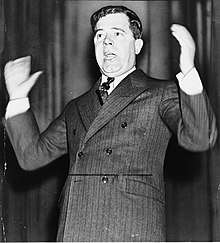
Russ Cohen
Vanderbilt coach Dan McGugin recommended Russ Cohen for the LSU job.[18] Cohen's best year at LSU was his first, in 1928. Led by All-Southern captain Jess Tinsley, Tigers posted a 6–2–1 record, suffering losses to Arkansas and Wallace Wade's Alabama Crimson Tide. Star halfback Percy Brown broke his shoulder against Alabama.[19] The tie was to Bill Banker and rival Tulane, which was as good as its ever been from 1929 to 1931. In 1931 LSU played its first night game in Tiger Stadium, a 31–0 victory over Spring Hill.
Southern prominence (1932–1957)
Biff Jones
Under West Point's Biff Jones, the 1932 team tied for the Southern Conference championship in its last season as a member of the conference. The 1933 lost no games and was led by track and field athlete Jack Torrance. Jones resigned after the 1934 season after a heated exchange with noted LSU supporter, Louisiana senator Huey P. Long.[20] In the last game of the season, Long was displeased after the team had lost two straight games and were trailing at halftime to Oregon. Long decided to give a motivational speech to the team at halftime, but was turned away by Jones at the locker room door.[21] The ensuing argument ended with Jones declaring to resign, effective at the end of the game.[20]
Gaynell Tinsley, the cousin of Jess, has a profile at the College Football Hall of Fame which describes him this way: "Tinsley was a magnificent athletic specimen, standing 6-0, and weighing 196-pounds, size he used equally well as a defensive stalwart who was a blocking master."[22] As a sophomore in 1934, Tinsley had a 65-yard pass reception, thrown by halfback Abe Mickal, against Southern Methodist University, which stood as a record for several years as "the longest pass in Southern football history."[22]
Bernie Moore era: First All-Americans
Under head coach Bernie Moore, LSU won their first Southeastern Conference (SEC) Championship finishing with a 5–0 conference record and 9–2–0 overall in 1935. LSU played in their first Sugar Bowl game, falling to No. 4 TCU 3–2 at Tulane Stadium. The Tigers and Horned Frogs both took home the Williamson Poll national championship, which is not claimed by LSU. End Gaynell Tinsley was named a consensus All-American in 1935 and 1936, becoming the first All-America selection for LSU. Coach Moore once said, "Tinsley could have made All-American at any position. He was so tough, he made blockers quit. He's the greatest lineman I ever saw." Along with Tinsley in the line were Marvin Stewart, Justin Rukas, and Jeff Barrett. In the backfield were Mickal, Jesse Fatherree, and Pinky Rohm – all members of LSU's "Early Days" team of the century.[23] The team's quarterback was Bill May, awarded the Jacobs Blocking Trophy in 1936.
The 1936 team won the school's second SEC Championship finishing with a 6–0 conference record and 9–1–1 overall. The Tigers finished runner-up to Minnesota in the AP Poll. LSU won the Williamson Poll and Sagarin Ratings national championships, which are not claimed by the school. LSU's largest margin of victory, and most points scored in a football game came on November 21, in a game at Tiger Stadium against USL (University of Southwestern Louisiana, now University of Louisiana Lafayette). The final score was LSU 93, USL 0. The 1937 team featured Ken Kavanaugh and was upset by Vanderbilt using a hidden ball trick, the school's first-ever victory over a ranked opponent.[24] This season also featured the first game in the Florida–LSU football rivalry, which was won 19–0 by LSU.
In 1939, in a game against Holy Cross, Kavanaugh caught four touchdown passes in the 26–7 win. According to Kavanaugh and teammate Young Bussey, Kavanaugh found four rusty nails on the sideline during the game. The next week against Rice, he found another nail and scored another touchdown to give LSU a 7–0 win. The pattern continued against Loyola and Vanderbilt, as Kavanaugh found two nails before each game and in each scored two touchdowns. A sportswriter for the Baton Rouge Advocate claimed he saw coach Moore at a local store stocking up on nails before LSU's game against No. 1 Tennessee.[25] Kavanaugh failed to score in the game, however, and the Tigers lost 20–0.[26] The Nashville Banner named Kavanaugh co-MVP of the Southeastern Conference along with Bob Foxx of Tennessee.[27][28] Kavanaugh was a consensus All-America selection for the 1939 All-America Team.
The 1943 team was led by Steve Van Buren, moved to running back because of a lack of players due to World War II conscription,[29] and won the Orange Bowl. Van Buren led the NCAA in scoring that season, with 98 points (110 including the bowl game).
The 1946 team played in one of the most notable instances of the Cotton Bowl Classic – "Ice Bowl." LSU, led by head coach Moore and quarterback Y. A. Tittle, entered the game against Arkansas with a 9–1 record. Ice, sleet and snow pelted the stadium as LSU players filled oil drums with charcoal and started fires for makeshift heaters while fans built fires in the stands. LSU dominated the game with a 271–54 advantage in total yards and 15–1 advantage in first downs, but that did not equate to the numbers on the scoreboard; the game ended in a 0–0 tie and LSU finished the season 9–1–1.
Gaynell Tinsley
In 1948, Moore retired, and Gaynell Tinsley, who had been working as an assistant, was promoted to replace his former mentor.[30] The 1949 team made it to the Sugar Bowl, where it was swamped by Oklahoma. Tinsley became the first person to participate in the Sugar Bowl as both a player and a head coach.[31] Tinsley's LSU teams never met with the same success they had achieved in 1949. In seven years as head coach at LSU, Tinsley's teams compiled a record of 35–34–6.[32]
National prominence (1958–1979)
Paul Dietzel: First national championship
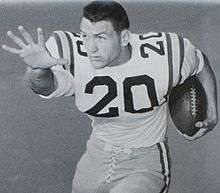
In 1955, Paul Dietzel became the head coach at LSU.[33] Jim Taylor was an All-American in 1957, and led the SEC in scoring in 1956 and 1957. During Dietzel's first three years, none of his teams had a winning season.
.jpg)
In 1958, however, Dietzel came up with a unique "three-platoon system." Instead of replacing individual players during the game, Dietzel would bring in an entirely new set of players between plays and series. The three teams were called the White Team (the first-string offense and defense), the Gold (Go) Team (the second-string offense), and the Chinese Bandits (the second-string defense). The system worked, as the 1958 team won the school's first claimed national championship, beating No. 12 Clemson 7–0 in the Sugar Bowl. The only score was a pass from Billy Cannon to sophomore Mickey Mangham, one of the smallest players on the team.
Cannon won the Heisman Trophy in 1959. On Halloween, late in the game between No. 1 LSU and No. 3 Ole Miss, LSU was trailing 3–0. Cannon returned a punt 89 yards for a TD, breaking seven tackles. This has become known as Cannon's Halloween Run. The Rebels then drove down the field but were stopped on the LSU 1-yard line as the game ended resulting in a 7–3 victory for LSU in Tiger Stadium. In the Sugar Bowl, one of the most anticipated rematches in college football history took place. This game, however, would not be the classic that transpired only weeks before. Ole Miss dominated the game from start to finish and came away with a decisive 21–0 win over the Tigers. LSU finished the season having only given up 29 points.
Charles McClendon
Dietzel left for Army after the 1961 season, and Charles "Charlie" McClendon, an assistant since 1953, was named his successor. McClendon picked up where McLendon left off, with three top ten finishes in his first four years.
Doug Moreau broke Fenton's record of 6 field goals in 1965. In the 1966 Cotton Bowl, unranked LSU upset undefeated and No. 2 ranked Arkansas, winning the game 14–7 and snapping Arkansas' 22-game winning streak.[34]

In 1972, number 6 LSU survived an upset bid from unranked Ole Miss in Tiger Stadium by winning the game on a touchdown pass from quarterback Bert Jones to running back Brad Davis. Ole Miss fans say the 1972 contest featured a few seconds of free football. The Tigers trailed the Rebels 16–10 with four seconds to play. After a lengthy incompletion by Jones, the game clock still showed one second remaining. The Tigers used the precious second to win the game on the last play, 17–16. A song was written to commemorate the game, called One Second Blues, which is featured on the album "Hey Fightin' Tigers".[35] The alleged home-clock advantage inspired a sign at the Louisiana state line, leaving Mississippi, reading, "You are now entering Louisiana. Set your clocks back four seconds."[36][37] For that year, the Ole Miss yearbook reported the score for the game as "Ole Miss 16, LSU 10 + 7 ".
Instability (1980–1999)
Jerry Stovall
After having just four coaches over 44 years from 1935 to 1979, the team went through eight coaches in a 20-year period from 1980 to 1999. This stretch began with the death of Bo Rein in a plane crash before coaching a single game for the Tigers.[38] Jerry Stovall was hired to replace Rein as head coach in 1980.[39]
LSU defeated Alabama 20–10 in Birmingham, Alabama in Bear Bryant's last game coaching against LSU, in 1982. LSU's defense held Alabama to 119 yards of total offense,[40] as the Tigers defeated the Tide for the first time since 1970. "You don't understand how it feels to get hit in the mouth for 11 years," Stovall said in the locker room after the game. "This is going to feel pretty good when it soaks in."[41]
1983 was the first season calling LSU football for radio play-by-play man Jim Hawthorne, who served in this role until the 2016 season and became known as the "Voice of the Tigers".[42] LSU finished that season with a record of 4–7, and Stovall was dismissed as LSU's head coach.[43]
Arnsparger, Archer, and Hallman
Only two hours after the firing of Stovall, LSU hired Miami Dolphins defensive coordinator Bill Arnsparger as head coach.[43]
In 1988, unranked LSU staged a near-literal, earth-shattering upset victory over No. 4 Auburn in Tiger Stadium, winning the game 7–6 with 1:41 remaining on a touchdown pass from quarterback Tommy Hodson to tailback Eddie Fuller. The reaction of the crowd was so immense that it registered as an earthquake on a seismograph in LSU's Howe-Russell Geoscience Complex.[44] It was later dubbed "The Earthquake Game" by ESPN.[45]
Gerry DiNardo
LSU hired Gerry DiNardo as head coach in 1995. That season, in an attempt to liven up the rivalry between LSU and Auburn, DiNardo had the team wear its white jerseys at home in Tiger Stadium for the first time since 1982.[46] In the game, LSU upset No. 5 Auburn, winning 12–6 as LSU defensive back Troy Twillie intercepted Auburn quarterback Patrick Nix's 11-yard pass into the end zone with no time remaining. The Tigers completed that season with a 7–4–1 record and defeated Michigan State in the 1995 Independence Bowl.[47]
After nine straight losses to Steve Spurrier-led Florida, the No. 14 Tigers defeated the No. 1 ranked defending national champion Gators 28–21 in Tiger Stadium in 1997. LSU running back Kevin Faulk was featured on the following week's cover of Sports Illustrated with the title "See you later, Gators."[48] It was the first time LSU defeated a No. 1 ranked team and the first time the goalposts were ever torn down in Tiger Stadium.[49]
Return to prominence (2000–present)
Nick Saban: Second national championship
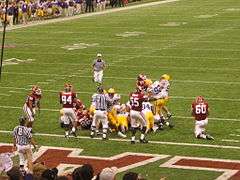
In head coach Nick Saban's first season of 2000, LSU returned to national prominence by beating No. 11 Tennessee in overtime 38–31 on ESPN, after which the goal posts were torn down for only the 2nd time in the history of Tiger Stadium. The victory over Tennessee also marked the first time that LSU played in an overtime game at home. Just a few weeks later, the goal posts were again ripped down as LSU beat Alabama 30–28 on CBS in Baton Rouge for the first time in 31 years. This was the 3rd and final time that the goal posts came down in Death Valley. In 2001, No. 21 LSU staged an upset victory over No. 2 Tennessee in the SEC Championship, winning 31–20. The victory earned LSU a spot in its first Sugar Bowl since 1986, and knocked the Volunteers out of national title contention. No. 16 LSU survived an upset bid from unranked Kentucky in 2002 by winning the game 33–30 on a miraculous 75-yard Hail Mary pass as time expired known as the "Bluegrass Miracle". Kentucky coach Guy Morriss had received the traditional Gatorade bath right before the Hail Mary. Kentucky fans, believing they had won, had already rushed the field and torn down one goal post.
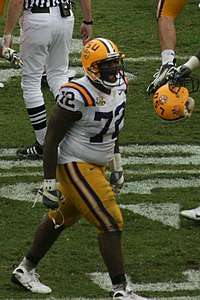
In 2003, No. 11 LSU outlasted No. 7 Georgia, 17–10. With ESPN College Gameday on hand for the first time since 1997, Quarterback Matt Mauck found wide receiver Skyler Green for a 34-yard touchdown with 3:03 remaining in the game. All-American cornerback Corey Webster sealed the victory with an interception in the final minute. The game is notable for the LSU fans chanting LSU-LSU after a Georgia touchdown. Georgia head coach Mark Richt was quoted as saying, "Usually when the opposing team does well, the crowd quiets down. All I began to hear was a chant 'L-S-U, L-S-U.' It got louder and louder and louder. It was the loudest I've ever heard a stadium." The win catapulted LSU onto the national scene. LSU won its second title and became the BCS national champion by defeating Oklahoma 21–14 in the 2004 Sugar Bowl (BCS National Championship Game).
Les Miles: Third national championship
In Les Miles's first season as head coach in 2005 at LSU was moved to Arizona State's Sun Devil Stadium due to the effects of Hurricane Katrina. With one endzone painted with "www.KatrinaSRF.com" and the other with "Together We Stand" along with logos of the states of Louisiana and Arizona, LSU rallied in the fourth quarter for a 35-31 comeback victory. Trailing 17–7 in the fourth quarter, LSU returned a blocked field goal and punt for touchdowns to ignite the comeback. The lead went back-and-forth with Arizona State taking a 31–28 lead with 4:07 to play. Quarterback JaMarcus Russell then lead the Tigers on a 10-play, 91-yard drive capped with a 39-yard touchdown pass to Early Doucet on fourth-and-10 to give LSU a 35–31 lead. LSU's defense then stopped Arizona State on downs at the LSU 30-yard line to secure the victory. In 2006, Russell completed a touchdown pass to WR Early Doucet with 9 seconds to go to beat Tennessee in Neyland Stadium after a breakout performance by Tennessee backup QB Jonathan Crompton.
No. 2 LSU played what was hyped as one of the most exciting games ever played in Tiger Stadium against No. 9 Florida in 2007. The game is also known for the LSU students leaving thousands of messages on the phone of Florida quarterback, Tim Tebow, prompting him to give a "telephone" hand gesture to the LSU student section following an early touchdown. Florida began the fourth quarter with a 24–14 lead, but behind solid defense and being a perfect 5 for 5 on fourth down conversions, the Tigers were able to take the lead 28–24 with 1:06 left in the game after a Jacob Hester touchdown to defeat the Gators. It was LSU's first national primetime game on CBS since 1981. LSU went on to defeat No. 1 Ohio State in the BCS national championship 38–24, becoming the first school to win two BCS national championship titles and improving their BCS record to 4–0, the best of any team. They also became the first two loss team to ever play in the BCS national championship.
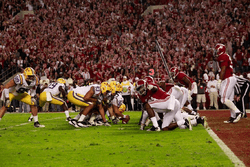
In the 5th game of the 2010 season, undefeated No. 12 LSU trailed the Volunteers 14–10 with 0:04 left on the clock and the ball spotted on Tennessee's 2-yard line. On 3rd and goal, after a failed quarterback sneak attempt and with time disappearing off the clock, LSU attempted to send in several players for a substitution package. Seeing that the time was about to expire, center T-Bob Hebert snapped the ball before quarterback Jordan Jefferson was ready, the ball was fumbled, Jefferson was tackled, and the clock expired. On further review, Tennessee was penalized half the distance to the goalline for illegal participation. Amid the confusion in the waning seconds, Tennessee coaches sent 4 players onto the field when they saw LSU make a substitution. Only two players then left the field, leaving the Volunteers with 13 players lined up on defense. Due to the penalty, LSU got the ball back for a single untimed play on the 1-yard line. With the last play, running back Stevan Ridley received the toss sweep, charging forward, only to be hit near the line of scrimmage, but continued to drive forward through two Tennessee defenders and into the endzone for the game-winning score.
The ninth regulation game of the 2011 season for LSU found the No. 1 nationally ranked Tigers against the No. 2 Alabama Crimson Tide in a match called "The Game of the Century"[50] or the "Matchup of the Year".[51] Both teams were undefeated and both were also coming off a bye week; viewed as important to the BCS Championship game as the "inside track" by many of the sportswriters, the press built up the game in a Super Bowl-style atmosphere. Ultimately, the game came down to field position and a series of field goals as the top-ranked defense of both teams prevented any touchdowns. Alabama missed three field goals and a fourth was blocked during regulation, leading to a 6–6 tie heading into overtime. On the first possession of overtime, Alabama again missed a field goal from 52 yards out, only to watch LSU earn the win on the next possession with a chip-shot field goal. As a result, it was the second-lowest scoring matchup between No. 1 and No. 2 teams in the history of the NCAA, with a 9–6 decision.[52] For the first time in BCS National Championship history, two SEC teams, the No. 1 LSU Tigers and the No. 2 Alabama Crimson Tide, again faced each other in the National Championship Game. Alabama won the game, 21–0. The SEC-only title game added impetus to the push for a national playoff system and hastened the death of the BCS system as implemented up to that time.[53]
Ed Orgeron
After the firing of Miles, offensive line coach Ed Orgeron became LSU's interim head coach. Later in 2016, he was hired as the full-time head coach.
See also
Notes
- An LSU baseball team had also worn purple and gold in its first varsity game against Tulane earlier in 1893, even though LSU's official colors at the time were actually blue and white.[1]
References
- Vincent 2008, p. 7.
- Vincent 2008, p. 8.
- Vincent 2008, p. 9.
- Bailey, John Wendell (1924). Handbook of Southern Intercollegiate Track and Field Athletics. Mississippi Agricultural and Mechanical College. p. 14.
- "Baton Rouge Wins Without Winning". The Daily Picayune. October 25, 1896. pg. 8.
- "Battles - The 9th Louisiana Infantry". Retrieved 2018-12-28.
- Letulle, Gayle. "Tulane Football History". tulane.edu. Archived from the original on December 26, 2014. Retrieved April 9, 2016.CS1 maint: unfit url (link)
- "George Doc Fenton".
- "From 'The LSU Football Vault': The 1908 Season".
- National Collegiate Athletic Association (1911). "Louisiana State University". The Official National Collegiate Athletic Association Football Guide: 227.
- "Tom Dutton".
- "Composite All-Southern Eleven Chosen By Eighteen Dopesters". Atlanta Constitution. December 2, 1913. p. 8. Retrieved March 3, 2015 – via Newspapers.com.

- National Association of Basketball Coaches of the United States; American Football Coaches Association (1922). Athletic Journal, Volume 3. Athletic Journal Publishing Company. p. 16. Retrieved April 9, 2016.
- Ronnie Thomas (April 26, 1968). "One Way To Break The Monotony". Times Daily.
- Vincent 2008, p. 36.
- "Another Break At Louisiana; Coach Quits". Pittsburgh Post-Gazette. Associated Press. December 29, 1927. p. 17. Retrieved April 3, 2016.
- Vincent 2008, p. 39.
- Edwin Pope (1955). Football's Greatest Coaches. Atlanta,: Tupper and Love. p. 341. Retrieved March 8, 2015 – via archive.org.

- http://grfx.cstv.com/schools/alab/graphics/docs/28-m-footbl-recap.pdf
- Vincent 2008, p. 49.
- Vincent 2008, p. 48.
- "Gaynell Tinsley". College Football Hall of Fame.
- http://www.lsusports.net/src/data/lsu/assets/docs/fb/pdf/01fb257-273.pdf?DB_OEM_ID=5200
- Peiser, Howell (October 26, 2004). "Flashback: Hidden-ball play beat LSU in 1937". scout.com. Retrieved April 9, 2016.
- "Nails Bring Ken Kavanaugh Luck Grabbing Passes". The Evening Independent. Associated Press. November 1, 1939. p. 16. Retrieved April 10, 2016.
- "Vols Vanquish L.S.U., 20 to 0". The Tuscaloosa News. Associated Press. November 5, 1939. p. 10. Retrieved April 15, 2016.
- Moshier, Jeff (December 30, 1939). "Playing Square". The Evening Independent. p. 18. Retrieved April 15, 2016.
- Scott 2008, p. 49.
- Vincent 2008, p. 57.
- "Gaynell Tinsley Gets Louisiana State Post". Eugene Register-Guard. Associated Press. March 11, 1948. Retrieved May 16, 2016.
- Johnson, Raymond (December 30, 1949). "Gus Tinsley First in History In Sugar Bowl as Player, Coach". The Tennessean. p. 25. Retrieved May 17, 2016.
- "LSU Shakes Up Athletic Department: Head Grid Coach Tinsley Fired". Council Bluffs Nonpareil. 1955-02-06.
- LSU Gumbo Yearbook 1956, LSU Press, p. 318-319.
- Schaeffer, Rick (2014). 100 Things Arkansas Fans Should Know & Do Before They Die. Triumph Books. p. 49. ISBN 978-1600789915. Retrieved February 28, 2016.
- "One Second Blues Song Info". AllMusic. All Media Network, LLC. Retrieved February 28, 2016.
- Walsh, Christopher J. (2006). Where Football Is King: A History of the SEC. Taylor Trade Publishing. ISBN 1461734770. Retrieved February 28, 2016.
- Stewart, Wayne (2015). You're the Ref: 174 Scenarios to Test Your Football Knowledge. Skyhorse Publishing, Inc. ISBN 978-1634509008. Retrieved February 28, 2016.
- Oller, Rob (January 5, 2008). "Promising start ended tragically". The Columbus Dispatch. Retrieved April 9, 2016.
- "Jerry Stovall Apparent Successor to Rein's Job". Sarasota Herald-Tribune. Associated Press. January 12, 1980. Retrieved April 9, 2016.
- "1982 University of Alabama Football Statistics" (PDF). Retrieved April 9, 2016.
- Alfano, Peter (November 7, 1982). "L.S.U Defeats Alabama". The New York Times. Retrieved April 9, 2016.
- Lowe, C. Kent (June 18, 2016). "Generations knew only Jim Hawthorne as Voice of the Tigers". The Advocate. Retrieved June 26, 2017.
- "LSU hires Arnsparger". The Index-Journal. Associated Press. December 3, 1983. p. 11. Retrieved July 5, 2017 – via Newspapers.com.
- "LSU vs Auburn seismogram, October 08, 1988 :: LSU University Archives Print Materials Collection". www.louisianadigitallibrary.org. Retrieved February 18, 2016.
- Henderson, Jeremy (September 17, 2012). "What really happened at the Auburn–LSU 'Earthquake Game'?". The War Eagle Reader. Retrieved May 15, 2014.
- Rosetta, Randy (September 17, 2015). "Former LSU coach Gerry DiNardo helped 'bring back the magic,' pump life into rivalry with Auburn: Podcast". The Times-Picayune. Retrieved July 5, 2017.
- "LSU blasts Michigan State for Independence Bowl title". The Galveston Daily News. Associated Press. December 30, 1995. p. 17. Retrieved July 5, 2017 – via Newspapers.com.
- "Photo Gallery: LSU Football on the cover of Sports Illustrated". lsusports.net. Louisiana State University. August 15, 2006. Retrieved April 9, 2016.
- "In No. 1 Upset of the Day, LSU Beats Florida, 28–21". Los Angeles Times. Associated Press. October 12, 1997. Retrieved April 9, 2016.
- Andy Staples (2011-11-06). "After all the buildup, Game of Century decided by ... kickers". Sports Illustrated. Retrieved 2011-11-06.
- Michael Bonnette (2011-11-05). "It's GameDay: The Matchup of the Year". Retrieved 2011-11-06.
- Jayson Love (2011-11-06). "5. Lowest Scoring No. 1 vs. No. 2 Matchup Since 1946". Bleacher Report. Retrieved 2011-11-06.
- Thomas Watts (2012-06-21). "College Football Playoff: I Didn't Say You Stole the Money". Bama Hammer. Retrieved 2012-08-06.
Bibliography
- Cowan, Barry; Jenkins, William L. (2013). Louisiana State University (illustrated ed.). Arcadia Publishing. ISBN 978-1467110983.
- Francis J., Fitzgerald, ed. (2002). Greatest Moments in Lsu Football History. Sports Publishing L.L.C. ISBN 1-58261-510-1.
- Mulé, Marty (2013). Game of My Life LSU Tigers: Memorable Stories of Tigers Football. Skyhorse Publishing. ISBN 978-1613215739.
- Scott, Richard (2008). SEC Football: 75 Years of Pride and Passion. Voyageur Press. ISBN 978-0-7603-3597-0.
- Vincent, Herb (2008). LSU Football Vault: The History of the Fighting Tigers. Whitman Publishing, LLC. ISBN 978-0794824280.